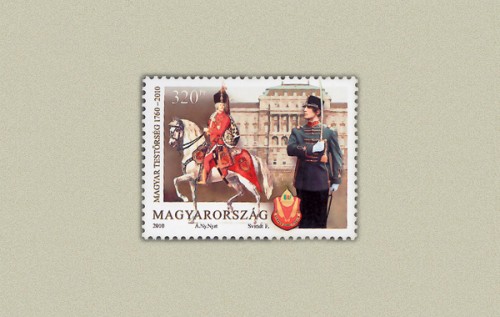
1. MAGYAR - 250 ÉVES A MAGYAR TESTŐRSÉG - Bélyeg rendelési kód: 2010 év bélyegei kompletten
2. ENGLISH - THE HUNGARIAN BODY GUARD IS 250 YEARS OLD - Order code of the stamp: 2010 Year stamps complete
3. GERMAN - 250 JAHRE UNGARISCHE LEIBWACHE - Die Bestellnummer Der Marke: 2010 Jahr Briefmarken komplett
Michel:
1. MAGYAR - 250 ÉVES A MAGYAR TESTŐRSÉG
A Magyar Posta alkalmi bélyeg kibocsátásával köszönti a 250 évvel ezelőtt alapított Magyar Testőrséget.
Mária Terézia magyar királynő elhatározása alapján 1760. március 1-jén a vármegyéket köriratban szólították fel a magyar testőrség megalakítására. A vármegyék fiatal nemesifjakat küldtek Pozsonyba, a Magyar Nemesi Testőrség megalakításának színhelyére. A szeptember 27-én felesketett gárdát október 4-én mutatták be Bécsben a királynőnek. Az első testőrkapitány 1760-62 között gróf Pálffy Lipót tábornagy volt, aki tábornoki rangú kapitánya volt a testőrségnek. 12 tiszt különböző szintű parancsnoki feladatokat látott el, mint testőr alkapitány, őrmester és alőrmester.
A 120 testőr alhadnagyi, vagy hadnagyi rangot kapott. Szolgálatukat 20-40 fős egységgel látták el a bécsi udvarban, ahol az uralkodói udvar kivonulásain díszes kíséretet alkottak. A királyi család magyarországi tartózkodási helyén – a budai várban – gyakran teljesítettek díszszolgálatot. Szabadidejükben gyalog és lovon végeztek katonai gyakorlatokat. Nyelveket, humán és reál ismereteket, vívást és udvari táncokat tanultak. Szolgálati idejük letöltését követően képzett és az udvari életben járatos nemesekként pályázhattak az udvari és vármegyei hivatalokra. Díszes, magyaros motívumokat tükröző öltözetük fő színei a vörös, a zöld és a sárga volt. Ezt egészítette ki ezüst csattal a vállon átvetett párducbőr.
1849-ben I. Ferenc József császár megszüntette a testületet, de koronázásakor Magyar Királyi Nemesi Testőrség néven ismét megszervezték. 1904-től a Magyar Királyi Darabont Testőrség látott el szolgálatot a budai várban. A két testület 1918-ig működött. 1920-ban Horthy Miklós kormányzóvá választása után szervezték meg a Magyar Királyi Testőrséget, mely megőrizte a korábbi testőrségek hagyományait és a kor követelményeinek megfelelően látta el a napi szolgálatot és a díszelgéseket. 1946-tól 1949-ig működött a Köztársasági Elnök Testőrsége és a Nemzetgyűlési Őrség.
1958-ban szervezték meg a BM Kormányőrséget, amely ellátta a párt- és állami vezetők, külföldi delegációk védelmét, az állam működése vonatkozásában kiemelkedően fontos épületek őrzését, az állami ünnepek és más protokolláris események alkalmával a díszelgő szolgálatot is. A Köztársasági Őrezred 1990-től hasonló feladatkörrel, kisebb mértékű névváltoztatásokkal végzi az előd szervezetek feladatait. 1992-től hagyományőrző egyenruhában teljesítenek díszszolgálatot. 2000. január 1-jétől átvették az Országház kupolatermében elhelyezett koronázási jelvények őrzését. (Forrás: Fazakas László írása a Magyar Testőrségről)
A bélyegkép bal oldalán a Magyar Testőrség egykori, jobb oldalán pedig mai egyenruhája látható. A bélyegkép előterében a Magyar Testőrség emblémája, hátterében pedig a Budai vár részlete tűnik elő. A bélyeghez tartozó alkalmi borítékon a Budai vár látképe és a bélyegképen is látható embléma ismétlődik. Az alkalmi bélyegzőn az embléma stilizált rajza található.
Forrás: Philatelia Hungarica Kft., Magyar Posta
2. ENGLISH - THE HUNGARIAN BODY GUARD IS 250 YEARS OLD
Magyar Posta is releasing a special stamp to mark the 250th anniversary of the formation of the Hungarian Body Guard.
Based on a decision by Queen Maria Theresa of Hungary, a circular document calling for the formation of the Hungarian Body Guard was sent to the historic counties of Hungary on 1 March 1760. Young nobles from the counties were sent to Pozsony (today Bratislava, Slovakia), where the Hungarian Noble Body Guard was founded.
The guards, who swore the oath of allegiance on 27 September, were presented to the queen in Vienna on 4 October. The first captain of the Guard between 1760 and 1762 was Count General Lipót Pálffy, who retained his superior rank as captain of the Guard. 12 officers performed command duties at different levels, such as those of vice-captain, sergeant and vice-sergeant. The 120 guards were given the rank of sub-lieutenant or lieutenant.
They served in 20 or 40 man units at the Viennese court, where they escorted the royal family’s entourage as a guard of honour. They frequently performed ceremonial duties at the royal family’s residence in Hungary, in the Buda Castle. When off duty, they practised military skills on foot or horseback. They studied languages, the classics and sciences, and learnt fencing and court dancing.
After their period of service, ex-guardsmen could apply for posts in court and county offices as accomplished nobles familiar with court life. The main colours of their decorative uniforms embellished with Hungarian motifs were red, green and yellow. This was supplemented by a leopard skin with a silver buckle thrown over the shoulder.
Emperor Franz Joseph I abolished the Guard in 1849, but it was re-established for his coronation under the name of the Hungarian Royal Noble Body Guard. From 1904 the Hungarian Royal Infantry Guard served at the Buda Castle. The two bodies operated until 1918. After the election of Regent Miklós Horthy in 1920, the Hungarian Royal Body Guard was re-organised. This fostered the traditions of earlier guards, and performed the daily and ceremonial duties required in the period.
Between 1946 and 1949 the Guard of the President of the Republic and the Parliamentary Guard operated. In 1958 the Ministry of the Interior’s Government Guard was formed to protect party and state leaders as well as foreign delegations, to guard buildings of outstanding importance for the functioning of the state, and to perform ceremonial duties on state occasions and at other protocol events. Since 1990, with the odd minor change to its name, the Republican Guard Regiment has performed similar duties to its predecessor organisations. Since 1992, they have performed ceremonial duties in historical dress uniform.
On 1 January 2000 they were entrusted with guarding the coronation insignia housed in the Dome Hall in the House of Parliament. (Source: László Fazakas on the Hungarian Body Guard)
On the left of the stamp design is the former uniform of the Hungarian Body Guard and on the right is today’s uniform. The emblem of the Hungarian Body Guard is in the foreground of the stamp with part of the Royal Palace in the Buda Castle in the background. On the first day cover for the stamp there is a view of the Buda Castle and the emblem featuring on the stamp design is repeated. The commemorative postmark is a stylised drawing of the emblem.
3. GERMAN - 250 JAHRE UNGARISCHE LEIBWACHE
Die Magyar Posta gibt anlässlich der vor 250 Jahren gegründeten Ungarischen Leibwache eine Sonderbriefmarke aus.
Auf Grund der Entscheidung der ungarischen Königin Maria Theresia wurden die Komitate am 1. März 1760 in einem Rundschreiben zur Gründung der ungarischen Leibwache aufgefordert. Die Komitate entsandten junge Edelknaben nach Preßburg, an den Schauplatz der Gründung der Leibwache der Ungarischen Edlen. Die am 27. September vereidigte Garde stellte man am 4. Oktober in Wien der Königin vor.
Der erste Gardekapitän zwischen 1760 und 1762 war Feldmarschall Graf Lipót Pálffy, der im Rang eines Generals Kapitän der Leibwache war. 12 Offiziere versahen verschiedene Generalsaufgaben als Unterhauptmann, Wachtmeister und Unterwachtmeister der Leibwache. Die 120 Leibwächter erhielten den Rang Unterleutnant oder Leutnant.
Ihren Dienst versahen sie in 20- bis 40-köpfigen Einheiten am Wiener Hof, wo sie an den Auszügen des Herrscherhofs das Ehrengeleit bildeten. An dem Aufenthaltsort der königlichen Familie in Ungarn – in der Burg von Buda – leisteten sie häufig Ehrenwache.
In ihrer Freizeit verrichteten sie Militärübungen zu Fuß oder zu Pferde. Sie lernten Sprachen, Human- und Realfächer, Fechten und Hoftänze. Nach Ableistung ihrer Dienstzeit konnten sie sich als gebildete und sich im Hofleben auskennende Adlige für Ämter am Hof oder in den Komitaten bewerben. Rot, grün und gelb waren die Hauptfarben ihrer verzierten, ungarische Motive tragenden
Dienstkleidung. Dies ergänzte ein mit Silberschnalle über die Schulter geworfenes Pantherfell.
1849 löste Kaiser Franz Joseph I. die Körperschaft auf, aber bei seiner Krönung wurde sie unter dem Namen Königlich Ungarische Adlige Leibgarde aufs Neue gegründet. Von 1904 versah die Königlich Ungarische Darabont Leibwache Dienst in der Burg von Buda. Die beiden Körperschaften waren bis 1918 aktiv. 1920, nach der Wahl von Miklós Horthy zum Gouverneur organisierte man die Königlich Ungarische Leibwache, welche die Traditionen der früheren Leibgarden bewahrte und den täglichen Dienst und die Ehrenwachen entsprechend den Anforderungen der Zeit versah.
Von 1946 bis 1949 waren die Leibgarde des Präsidenten der Republik und die Parlamentswache in Dienst. 1958 wurde die Regierungswache des Innenministeriums gegründet, die den Schutz der Partei- und Staatsführer sowie der ausländischen Delegationen, die Bewachung von aus Staatssicherheitsgründen herausragend wichtigen Gebäuden und anlässlich von Staatsfeiertagen und anderen Protokollereignissen auch Paradedienste versah.
Das Wachregiment der Republik versieht seit 1990 die Aufgaben der Vorgängerorganisationen mit ähnlichem Aufgabenkreis und geringfügigen Namensänderungen. Von 1992 verrichten sie die Ehrenwache in traditioneller Uniform. Mit Wirkung vom 1. Januar 2000 übernahmen sie die Bewachung der in der Kuppelhalle des Parlaments untergebrachten Krönungsinsignien. (Quelle: Schrift von László Fazakas über die Ungarische Leibwache)
Auf dem Briefmarkenbild links ist die einstige und rechts die jetzige Uniform der Ungarischen Leibwache zu sehen. Im Vordergrund des Briefmarkenbildes erscheint das Emblem der Ungarischen Leibwache, im Hintergrund des Bildes eine Teilansicht der Burg von Buda. Auf dem zur Marke gehörenden Sonderumschlag wiederholen sich die auch auf dem Briefmarkenbild zu sehende Ansicht der Burg von Buda und das Emblem. Auf dem Sonderstempel ist die stilisierte Zeichnung des Emblems aufzufinden.










